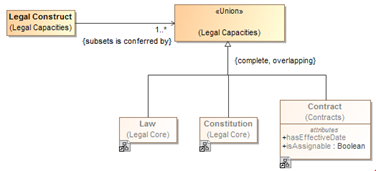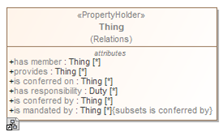A property is not limited to a minimum and a maximum cardinality (known as multiplicity) for just one type. A property can have a multiplicity for a superclass, while at the same time having a more specific multiplicity for one or more subclasses of that superclass. This constraint is known as an existential quantification (∃) or qualified constraint. This type of constraint is an assertion that, among other possible values, the number of values of one of these subclasses is between some minimum and maximum cardinality. Adding an existential quantification constraint does not define a new property, rather it constrains an existing property. Note that an existential quantification constraint must have a minimum cardinality of at least one in order to meet the definition of “existential” for the constraint. In the concept modeling interpretation of UML, subsetting a property without giving the new property a different name (or leaving off the new property name altogether) creates an existential quantification constraint. As {subsets} with an omitted name is not well defined in UML, in the concept modeling profile it is used to state that a subset of values must meet the stated cardinality and type constraints of the subsetting property. It does not create a new property, although it does create a context in which this constraint holds: the owning class and its subclasses.
The next diagram shows an existential quantification constraint on the global property “is conferred by” (from the property holder “Thing”). The multiplicity is such that at least one of the instances of the property constraint must be one of the types in the union.
Note
The property adding the constraint is unnamed. An unnamed property is equivalent, in this case, to naming this property the same as the property being constrained (“is conferred by” from the property holder “Thing”).
An existential qualification constraint on property 'is conferred by'.
Note
- In the Concept Modeler, the existential quantification constraint of a property must have a minimum multiplicity of at least one. If the minimum multiplicity of a property that restricts another property is, for example, 0..5 or 0..*, the Concept Modeler will adjust it to 1..5 or 1..*.
- Multiplicity values of *, 0..*, and Unspecified all mean the same thing.
Related page

